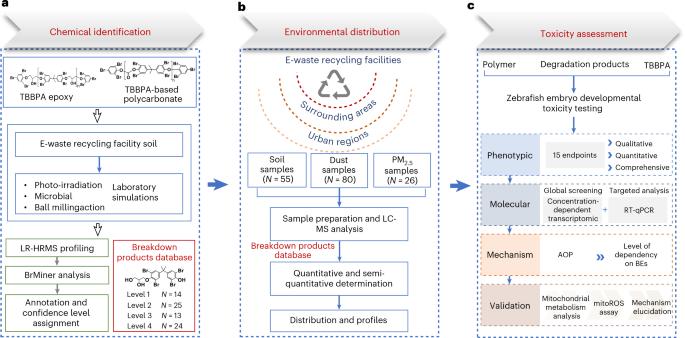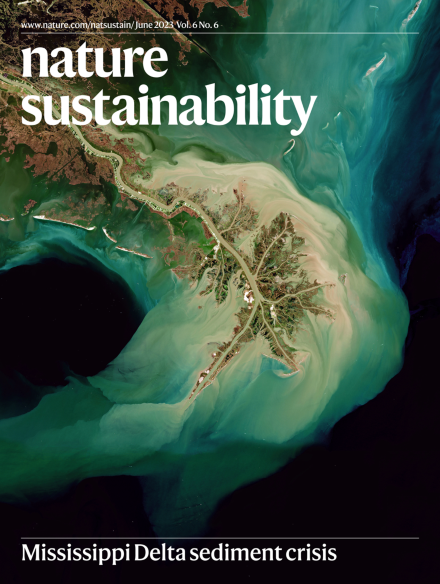聚合物阻燃剂分解对环境的影响
IF 27.1
1区 环境科学与生态学
Q1 ENVIRONMENTAL SCIENCES
引用次数: 0
摘要
由于单体卤代阻燃剂对人类和生态系统的毒性,其工业用途现已逐步淘汰。聚合物阻燃剂作为一种“安全”的替代品正在兴起,因此具有很高的产量和消费量。然而,其衍生物的环境命运和毒性仍然未知,因此难以理解和充分管理相关风险。我们以两种广泛用于电子产品的四溴双酚基聚合物(polyTBBPAs)作为模型阻燃化学品,研究它们在环境中分解时的行为及其衍生产品的毒性。我们的研究结果表明,聚tbbpa在环境中会分解成更小的产物。使用我们开发的一种名为BrMiner的非靶标筛选策略,我们鉴定了76种分子量在400-2,000 Da范围内的polytbbpa分解产物。这些是在华南电子废物回收设施的环境样本中检测到的。对斑马鱼胚胎的毒性测试表明,当它们在环境中分解时,多tbbpa的毒性会更大,线粒体功能障碍是一个关键的毒性机制。这项研究表明,聚合物阻燃剂存在环境风险,因此,它们的使用应该得到充分的评估和监管。作为有害的单体卤化阻燃剂的“安全”替代品,近年来聚合物阻燃剂的使用激增。作者指出,聚合阻燃剂在环境中分解成小的有毒分子,会对环境造成危害。本文章由计算机程序翻译,如有差异,请以英文原文为准。

Environmental impacts of polymeric flame retardant breakdown
The industrial use of monomeric halogenated flame retardants has now gradually been phased out due to their toxicity to humans and ecosystems. Polymeric flame retardants are emerging as a ‘safe’ alternative and so have a high production and consumption volume. However, the environmental fate and toxicity of their derivatives remain unknown, making it difficult to understand and adequately manage the associated risk. We take two tetrabromobisphenol A-based polymers (polyTBBPAs) that are widely used in electronics as model flame-retardant chemicals, and we study their behaviour when they break down in the environment and the toxicity of the derivative products. Our results show that polyTBBPAs break down into smaller products in the environment. Using a non-target screening strategy called BrMiner developed by us, we identified 76 breakdown products of polyTBBPAs with molecular weights in the range 400–2,000 Da. These were detected in environmental samples taken from electronic waste recycling facilities in South China. Toxicity tests with zebrafish embryos showed that when they break down in the environment, polyTBBPAs become more toxic, with mitochondrial dysfunction representing a key toxicity mechanism. This study reveals that there are environmental risks associated with polymeric flame retardants, and therefore, their use should be adequately assessed and regulated. As a ‘safe’ alternative to harmful monomeric halogenated flame retardants, the use of polymeric flame retardants has surged in recent years. The authors show that polymeric flame retardants break down in the environment into small toxic molecules that can pose environmental hazards.
求助全文
通过发布文献求助,成功后即可免费获取论文全文。
去求助
来源期刊

Nature Sustainability
Energy-Renewable Energy, Sustainability and the Environment
CiteScore
41.90
自引率
1.10%
发文量
159
期刊介绍:
Nature Sustainability aims to facilitate cross-disciplinary dialogues and bring together research fields that contribute to understanding how we organize our lives in a finite world and the impacts of our actions.
Nature Sustainability will not only publish fundamental research but also significant investigations into policies and solutions for ensuring human well-being now and in the future.Its ultimate goal is to address the greatest challenges of our time.
 求助内容:
求助内容: 应助结果提醒方式:
应助结果提醒方式:


